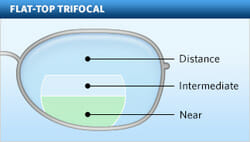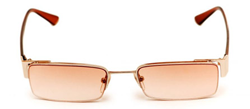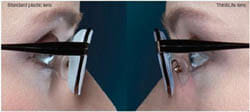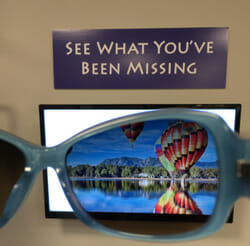All About Lenses
Your lenses are the one thing standing between your eyes and crisp vision. There are several options that can be done to fit the needs of your glasses and lifestyle. Check out below for more in-depth information about each of these lens types and treatments.

Anti-Reflective Treatment
What is anti-reflective treatment?
Anti-reflective (AR) treatment is a multi-layered formula that reduces or eliminates the glare, reflections, and “ghost images” that normal lenses produce. Anti-reflective coatings increase light transmission through the lenses to 99.5 percent. It makes it easier to see and easier for others to see you. These coatings are especially useful for those viewing computer screens and driving at night.
Why choose anti-reflective treatment?
Anti-reflective treatment reduces both internal and external reflections on the lenses themselves, creating a nicer cosmetic appearance. Internal reflections appear as rings that make lenses look thick. External reflections mask your eyes from a clear, complete view when someone is looking at you. So with an anti-reflective coating, eyeglass lenses appear thin or non-existent, and your eyes look more natural.
Anyone on TV or whose photo is taken often benefit tremendously from the coating, but really, all eyeglass wearers would benefit from an anti-reflective treatment from a cosmetic point of view. If you have a strong prescription, you can use the AR treatment in conjunction with high-index lenses to make your glasses look and feel as thin as possible. Blue light blocking can be added to anti-reflective treatment.
What is blue light?
Blue light is located at an area of the light spectrum that can be harmful to your eyes. Because it’s a short wavelength, high-energy blue light scatters more easily than other visible light making it harder to be focused. The loss of focus of the light wavelength creates visual “noise” that can reduce contrast and contribute to digital eye strain.
Why is blue light harmful?
Blue light in significant amounts can be harmful in many ways. The two that are most detrimental are that of digital eye strain, symptoms look like tiredness, dry eyes, red eyes, headaches, and blurred vision. The other is a disruption of the sleep cycle which affects our daily lives with increased fatigue.
Where is Blue light coming from?
Blue light’s biggest source is the sun. However, you can find blue light in LED light bulbs, computers, tablets, phones, and televisions

Scratch Resistant Treatment
What is scratch-resistant treatment?
Scratch-resistant treatment is a clear hard layer that can be applied to your glasses to make them more resistant to scratches. No eyeglass lens material – not even glass – is scratch-proof. However, a lens that is treated with scratch-resistant treatment becomes more resistant to scratching, whether it’s from dropping your glasses on the floor or occasionally cleaning them with a paper towel. Kids’ lenses, especially, benefit from a scratch-resistant hard coat.
Why choose scratch-resistant treatment?
If you have hard resin lenses (CR-39), you should consider getting a scratch-resistant treatment. Resins and plastics are more susceptible to scratches than glass. Scratches damage the cosmetic look of the lenses as well as their performance. With a scratch-resistant treatment, you don’t have to worry so much about minor scratches on your lenses. Another advantage of scratch-resistant treatments is that most treatments come with a one-year warranty. They are a great investment to prevent minor scratches. However, it is important to remember that scratch-resistant does not mean scratch-proof. All lenses are susceptible to scratches.
Since a scratch-resistant treatment can’t completely protect your lenses from wear and tear, do keep your glasses in a cushioned case, and clean them with a microfiber cloth and the cleaning solution your optician recommends. Also, be wary of those products that promise to repair your scratched lenses. They may fill in the cracks of the scratches, but it is nearly impossible for them to make the scratches disappear so the lenses look new again
Photochromic Lenses

Transitions and Transition XTRActive
What are Photochromic Lenses?
Photochromic lenses change from light to dark depending on the amount of ultraviolet light they are exposed to. The change is caused by photochromic molecules that are found throughout the lens or in a coating on the front of the lens. When the wearer goes outside, the lenses darken or tint. When the wearer goes back inside, the glasses become clear.
Why choose Photochromic Lenses?
Convenience – If you’ve ever felt frustrated at needing prescription glasses and prescription sunglasses to accommodate an outdoor lifestyle, you should consider photochromic lenses. There are a variety of photochromic options available. Depending on what you choose, you can customize the lenses to your needs. Some lenses darken only in direct sunlight, while others darken in little or no direct light. Some are designed to darken while you’re in the car to reduce road glare while you’re driving. You can even choose the color of the tint. Ask your doctor what options are available.
Multifocals

Progressive Lenses
For many presbyopes, bifocal lenses are a necessity. But, it can be difficult to adjust to the harsh line that is found in bifocal lenses. Fortunately, there are lenses available with no-line; these are called progressive lenses. No more lines! Just a gradual change in focusing power which allows you to comfortably focus on any distance. Just like bifocals, distant objects are viewed through the top portion of the lenses, and near objects are viewed through the bottom portion of the lenses. The benefit now is, no one knows it but you!

Bifocal Lenses
For many people, different lenses are needed for seeing at different distances. Bifocal lenses allow the wearer to look through two areas of the lens. One area focuses on distant objects. The other is used for reading. A little-known fact is that bifocals were invented by Benjamin Franklin, and his style of bifocals are still available today.
Most of the time the “reading” area is smaller, shaped like a sideways “D”, and found in the lower hemisphere of the lens. These bifocals are called line bifocals or flat-tops. If you are focusing on distant objects, you look through the top half of the lenses. To read a book, magazine, or newspaper, you look through the “reading” area. One thing that is difficult about using bifocals is dealing with the line between the two vision areas.
Fortunately, recent technologies have developed a new type of lens, called the no-line, or progressive lens.

Trifocal Lenses
Bifocals allow the wearer to read through one area of the lens, and to focus on distant objects through another area of the lens. As the eyes age, though, a stronger prescription is needed to read. This would be fine, but the stronger prescription that allows for reading makes it difficult to focus on objects at intermediate distances, such as grocery items on a shelf or your speedometer. Thus, trifocals are necessary for a third prescription for intermediate focusing.
Lens Tints

Cosmetic and Specialty Tints
If you wear glasses, remember that they not only help you see but they contribute to how others see you as well. The proper lens tint can make working at a computer more comfortable, reduce glare when driving, allow a target shooter to see the target more clearly, enhance the wearer’s appearance by hiding fine wrinkles around the eyes or simply help the wearer make a desired fashion statement. Tinted sports wear can give you a competitive advantage to see the ball better, read the greens easier and more. Cosmetic tints offer a variety of colors and shades to meet your needs. You can choose light blue or any color under the rainbow. Some lenses are clear at the bottom and gradually get more colored towards the top of the lenses. There are many ways to adjust your lenses to whatever style suits your personality and your lifestyle.
Thinner/Lighter Glasses

High Index Lenses
Years ago the only materials available to use for lenses were glass and a hard resin called CR-39. But in recent years high index lenses have become available. High index materials are named because they have a higher index of light refraction. Basically, they can do the same job that glass or CR-39 does, but high index lenses are much thinner and lighter. With high index lenses, you can avoid having “soda bottle” lenses.
When speaking about high index lenses, you may hear many unfamiliar numbers and terms. Here are a few things to remember…
Polycarbonate
The first and still most popular high index plastic is polycarbonate. Polycarbonate was originally developed for fighter jet cockpits. It is very strong, very light, and resistant to scratches and impact. Most sports lenses are made of polycarbonate.
Trivex
Trivex lenses, which rival polycarbonate lenses as the safest lenses on the market, are made of an exceptionally clear, lightweight lens materials, which translates into excellent all-day wearing comfort. You will experience superior eye protection, sharp vision, and lightweight comfort — all in the same lenses.
High-Index
High index lenses, such as 1.67, and1.74, are much thinner than regular glass or plastic. Talk with your doctor to decide which high index lens is right for you.
Polarized Lenses

Polarized Lenses
Polarized sunglasses help reduce the glare from the road, windshield, cars, and other reflecting surfaces. Glare from wet roads, light reflecting off other vehicles, and glare from your own windshield can be annoying and dangerous. Polarized lenses eliminate almost all glare, reducing eye strain and increasing visibility.
There are some limitations to the use of polarized lenses, however. Because the vertical polarizing stripes reduce the amount of light entering the eye, polarized lenses cannot be used for regular eyewear with clear lenses. Prescription sunglasses can be tinted a very light gray to accommodate the polarized laminate, but most contact lenses cannot. Some drivers discover that polarized lenses can cause distortions in liquid crystal displays (LCDs). Onboard clocks and other instrument displays may be temporarily unreadable. The result is a glare-reduced view of the world. Polarized lenses can make a world of difference for any outdoor enthusiast. Fisherman can eliminate the bright reflections from the water and actually see into the water more easily than with any other sunglasses, golfers can see the green easier, and joggers and bikers can enjoy reduced glare from the road. In addition, drivers can enjoy the safety and comfort that polarized lenses provide while driving.
Custom Polarized Sun Clips

Custom Polarized Sun Clips
Easily transform your current pair of glasses into great polarized sunglasses. Each pair of sun clips are custom made to fit your current frame.
Custom polarized sun clip features: custom made, fits virtually any frame, extremely lightweight, 24 polarized lens colors to choose from including solid, mirror and gradient colors. Even add a little style to your sunglasses with your choice of 12 Swarovski crystal colors.
Sunwear

Sunwear
Sunglasses are essential for protecting eyes from sun damage, they also improve vision. Sunglasses are important for people of all ages. Many experts believe our eyes get 80 percent of their total lifetime exposure to the sun’s UV rays by age 18. And since excessive lifetime exposure to UV radiation has been linked to the development of cataracts and other eye problems, it’s never too early for kids to begin wearing good quality sunglasses outdoors.
Sunglasses can range from poor to excellent protection from UVA and UVB light. Less expensive sunglasses are available, but you need to look closely at the UV protection they provide. At Complete Family Eyecare we provide the best protection from the sun. We carry a large selection of styles and colors to meet the needs of your lifestyle.
Another product to consider is polarized sunglasses. Polarized lenses block light reflected from surfaces like a flat road or smooth water. If you’re involved in activities like water sports, skiing, golfing, biking, fishing, and even driving, polarized lenses can be very helpful in reducing glare and giving a clearer view.
Sport Lenses

Sport Lenses
If you play sports, you should keep two things in mind related to your vision: protection and precision. Sports lenses protect the wearer’s eyes. Sports like tennis, baseball, softball, and racquetball may see ball speeds of 90mph or more. In baseball alone, there are over 500,000 injuries per year! But that’s not the most common eye injury. Most eye injuries occur in basketball, where an elbow or a finger jabbed into the eye can cause corneal abrasions, fractured bones, retinal detachments, or even blindness.
Polycarbonate lenses are more resistant to impact than glass or plastic and offer protection for 90% of eye injuries. Protective eyewear fits well, features a padded bridge, has prescription or non-prescription lenses, and deep-grooved eyewires to prevent the lens from falling out.
The specialized lenses also optimize your vision. In addition to protecting your eyes certain additions can be made to your sports lenses to give you a competitive advantage. Depending on your sport, certain lenses are more appropriate than others. Dark, UV protection lenses, polarized lenses, tinted lenses are available to enhance your performance in baseball, fishing, shooting, golfing, skiing, biking and more. Even if you don’t normally wear glasses, non-prescription sports lenses can benefit your performance. Some people think that lenses prevent the wearer from seeing the action, but many sports lenses have anti-fog, glare reduction, increased peripheral vision and scratch resistant properties, which provide an advantage. Discuss your sports needs with us anytime at Complete Family Eyecare.
